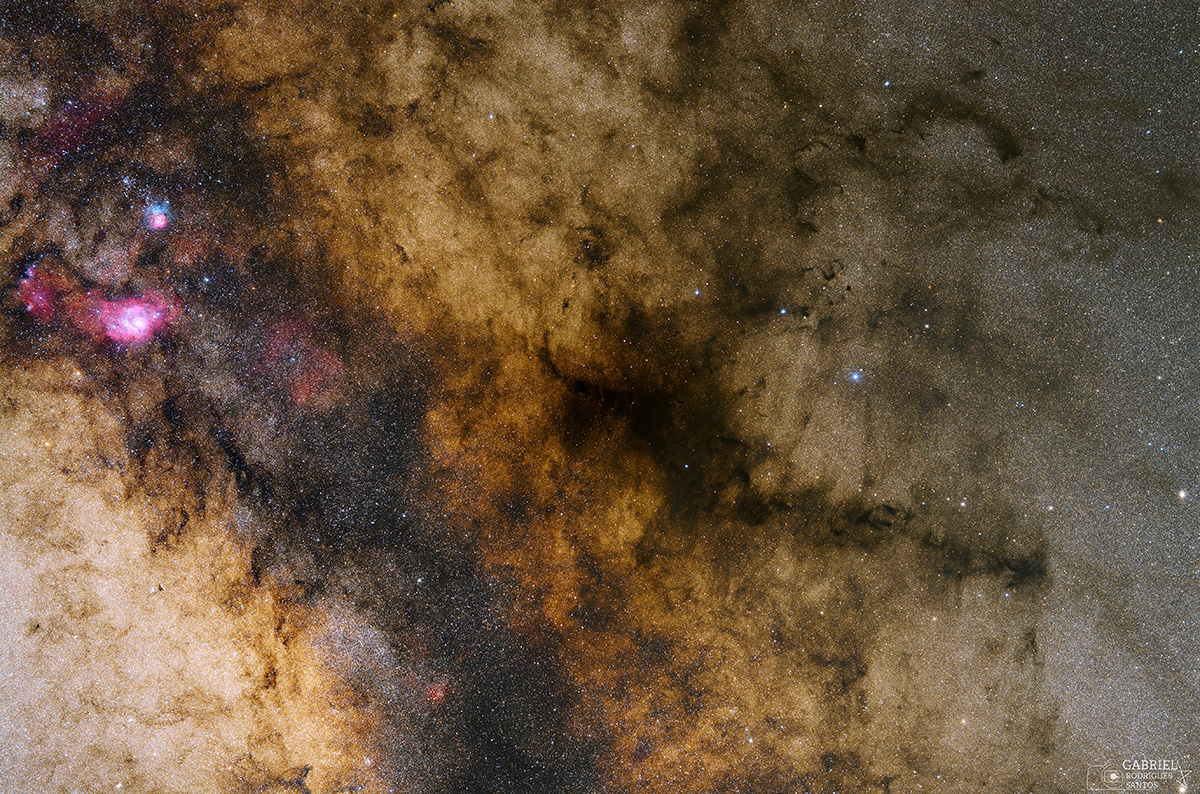01. October 2021
Tī 銀河中心 ùi 內海仔星雲 kàu 薰吹星雲

探索宇宙1!逐工會揀一幅無仝款 ê 影像抑是相片,𤆬你熟似咱這个迷人 ê 宇宙,閣有專業天文學者2為你3解說4。
- 原始文章:The Central Milky Way from Lagoon to Pipe
- 影像來源 kah 版權:Gabriel Rodrigues Santos
- 台文翻譯:An-Li Tsai (NCU)
[漢羅] Tī 銀河中心 ùi 內海仔星雲 kàu 薰吹星雲
這个恆星景色內底有 烏暗 ê 雲斑 kah 彩色 ê 雲彩。 這幅深空寬闊 ê 影像迒過咱銀河系中心密實 ê 恆星場,規个範圍有超過 30 粒月娘遐爾闊。 正爿霧霧 ê 星際塗粉雲,tī 20 世紀初 to̍h 去予天文學家 E. E. Barnard kā 編做目錄。 遮有 B59, B72, B77, kah B78,攏是蛇夫座分子複合體 ê 一部份,離咱 kan-na 450 光年遠爾爾。 In 鬥做伙 ê 外形看起來 to̍h 親像是薰吹 kah 碗,所以這个暗星雲才會去予叫做 薰吹星雲。 倒爿遐有三个足光 ê 星雲鬥陣做伙 ê 所在,是恆星托兒所。 In to̍h tī 人馬座 ê 方向,離咱有 5000 光年遠。 Tī 18 世紀,天文學家 Charles Messier kā 其中兩个收入去伊 ê 星團星雲目錄。 M8 是這个 三人組內底上大 ê,彩色 ê M20 to̍h tī 伊 ê 面頂。 上倒爿是第三个有名 ê 發射區,內底有 NGC 6559。 M20 去予塗粉帶分做兩爿,伊嘛叫做 三叉星雲。 M8 有名 ê 外號 to̍h 叫做 內海仔星雲。
[POJ] Tī Gîn-hô tiong-sim ùi Lāi-hái-á seng-hûn kàu Hun-chhoe seng-hûn
Chit-ê hêng-chhiⁿ kéng-sek lāi-té ū o͘-àm ê hûn-pan kah chhái-sek ê hûn-chhái. Chit-pak chhim-khong khoan-khoah ê iáⁿ-siōng hāⁿ kòe lán Gîn-hô-hē tiong-sim ba̍t-cha̍t ê hêng-chhiⁿ-tiûⁿ, kui-ê hoān-ûi ū chhiau-kòe saⁿ-cha̍p lia̍p goe̍h-niû hiah-nī khoah. Chiàⁿ-pêng bū-bū ê seng-chè-thô͘-hún-hûn, tī tī jī-cha̍p sè-kí chho͘ to̍h khì hō͘ thian-bûn-ha̍k-ka E. E. Barnard kā piàn-chò bo̍k-lo̍k. Chia ū B-gō͘-cha̍p-káu, B-chhit-cha̍p-jī, B-chhit-cha̍p-chhit, kah B-chhit-cha̍p-poeh, lóng-sī Siâ-hu-chō hun-chú-ho̍k-ha̍p-thé ê chi̍t-pō͘-hūn, lî lán kan-na sì-pah-gō͘-cha̍p kng-nî hn̄g niā-niā. In tàu-chò-hóe ê gōa-hêng khòaⁿ--khí-lâi to̍h chhiⁿ-chhiūⁿ sī hun-chhoe kah óaⁿ, só͘-í chit-ê àm-seng-hûn chiah-ē khì hō͘ kiò-chò Hun-chhoe seng-hûn. Tò-pêng hiah ū saⁿ-ê chiok-kng ê seng-hûn tàu-tīn chòe-hóe ê só͘-chāi, sī hêng-chhiⁿ-thok-jî-só͘. In to̍h tī Jîn-má-chō ê hong-hiòng, lî lán ū gō͘-chheng kng-nî hn̄g. Tī cha̍p-poeh sè-kí, thian-bûn-ha̍k-ka Charles Messier kā kî-tiong nn̄g-ê siu-ji̍p-khì i ê seng-thoân seng-hûn bo̍k-lo̍k. M-poeh sī chi̍t-ê saⁿ-lâng-cho͘ lāi-té siōng-tōa ê, chhái-sek ê M-jī-cha̍p to̍h tī i ê bīn-téng. Siōng tò-pêng sī tē-saⁿ-ê ū-miâ ê hoat-siā-khu, lāi-té ū NGC lio̍k-ngó͘-ngó͘-kiú. M-jī-cha̍p khì hō͘ thô͘-hún-tòa pun-chòe nn̄g-pêng, i mā kiò-chò Sam-chhe-seng-hûn. M-poeh ū-miâ ê gōa-hō to̍h kiò-chò Lāi-hái-á seng-hûn.
[KIP] Tī Gîn-hô tiong-sim uì Lāi-hái-á sing-hûn kàu Hun-tshue sing-hûn
Tsit-ê hîng-tshinn kíng-sik lāi-té ū oo-àm ê hûn-pan kah tshái-sik ê hûn-tshái. Tsit-pak tshim-khong khuan-khuah ê iánn-siōng hānn kuè lán Gîn-hô-hē tiong-sim ba̍t-tsa̍t ê hîng-tshinn-tiûnn, kui-ê huān-uî ū tshiau-kuè sann-tsa̍p lia̍p gue̍h-niû hiah-nī khuah. Tsiànn-pîng bū-bū ê sing-tsè-thôo-hún-hûn, tī tī jī-tsa̍p sè-kí tshoo to̍h khì hōo thian-bûn-ha̍k-ka E. E. Barnard kā piàn-tsò bo̍k-lo̍k. Tsia ū B-gōo-tsa̍p-káu, B-tshit-tsa̍p-jī, B-tshit-tsa̍p-tshit, kah B-tshit-tsa̍p-pueh, lóng-sī Siâ-hu-tsō hun-tsú-ho̍k-ha̍p-thé ê tsi̍t-pōo-hūn, lî lán kan-na sì-pah-gōo-tsa̍p kng-nî hn̄g niā-niā. In tàu-tsò-hué ê guā-hîng khuànn-khí-lâi to̍h tshinn-tshiūnn sī hun-tshue kah uánn, sóo-í tsit-ê àm-sing-hûn tsiah-ē khì hōo kiò-tsò Hun-tshue sing-hûn. Tò-pîng hiah ū sann-ê tsiok-kng ê sing-hûn tàu-tīn tsuè-hué ê sóo-tsāi, sī hîng-tshinn-thok-jî-sóo. In to̍h tī Jîn-má-tsō ê hong-hiòng, lî lán ū gōo-tshing kng-nî hn̄g. Tī tsa̍p-pueh sè-kí, thian-bûn-ha̍k-ka Charles Messier kā kî-tiong nn̄g-ê siu-ji̍p-khì i ê sing-thuân sing-hûn bo̍k-lo̍k. M-pueh sī tsi̍t-ê sann-lâng-tsoo lāi-té siōng-tuā ê, tshái-sik ê M-jī-tsa̍p to̍h tī i ê bīn-tíng. Siōng tò-pîng sī tē-sann-ê ū-miâ ê huat-siā-khu, lāi-té ū NGC lio̍k-ngóo-ngóo-kiú. M-jī-tsa̍p khì hōo thôo-hún-tuà pun-tsuè nn̄g-pîng, i mā kiò-tsò Sam-tshe-sing-hûn. M-pueh ū-miâ ê guā-hō to̍h kiò-tsò Lāi-hái-á sing-hûn.
[English] The Central Milky Way from Lagoon to Pipe
Dark markings and colorful clouds inhabit this stellar landscape. The deep and expansive view spans more than 30 full moons across crowded star fields toward the center of our Milky Way Galaxy. Cataloged in the early 20th century by astronomer E. E. Barnard, the obscuring interstellar dust clouds seen toward the right include B59, B72, B77 and B78, part of the Ophiuchus molecular cloud complex a mere 450 light-years away. To the eye their combined shape suggests a pipe stem and bowl, and so the dark nebula's popular name is the Pipe Nebula. Three bright nebulae gathered on the left are stellar nurseries some 5,000 light-years distant toward the constellation Sagittarius. In the 18th century astronomer Charles Messier included two of them in his catalog of bright clusters and nebulae; M8, the largest of the triplet, and colorful M20 just above. The third prominent emission region includes NGC 6559 at the far left. Itself divided by obscuring dust lanes, M20 is also known as the Trifid. M8's popular moniker is the Lagoon Nebula.
詞彙學習
| 漢羅 | POJ | KIP | 華語 | English |
|---|---|---|---|---|
| 內海仔星雲 | Lāi-hái-á seng-hûn | Lāi-hái-á sing-hûn | 潟湖星雲 | the Lagoon Nebula |
| 薰吹星雲 | Hun-chhoe seng-hûn | Hun-tshue sing-hûn | 煙斗星雲 | the Pipe Nebula |
| 薰吹 | hun-chhoe | hun-tshue | 煙斗 | pipe stem |
| 蛇夫座 | Siâ-hu-chō | Siâ-hu-tsō | 蛇夫座 | Ophiuchus |
| 暗星雲 | àm-seng-hûn | àm-sing-hûn | 暗星雲 | dark nebula |
| 人馬座 | Jîn-má-chō | Jîn-má-tsō | 人馬座 | Sagittarius |
| 三裂星雲 | Saⁿ-lih-seng-hûn | Sann-lih-sing-hûn | 三裂星雲 | the Trifid |
| 三叉星雲 | Sam-chhe-seng-hûn | Sam-tshe-sing-hûn | 三裂星雲 | Trifid Nebula |
| 分子複合體 | hun-chú-ho̍k-ha̍p-thé | hun-tsú-ho̍k-ha̍p-thé | 分子複合體 | molecular complex |
| 恆星場 | hêng-chhiⁿ-tiûⁿ | hîng-tshinn-tiûnn | 恆星場 | star field |
| 塗粉帶 | thô͘-hún-tòa | thôo-hún-tuà | 灰塵帶 | dust lane |
| 恆星托兒所 | hêng-chhiⁿ-thok-jî-só͘ | hîng-tshinn-thok-jî-sóo | 恆星托兒所 | stellar nursery |